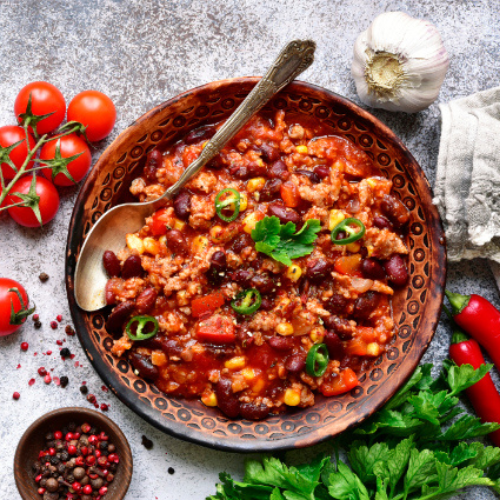How to Make Chilli: The Ultimate Guide to Perfect Homemade Chili
If you’ve ever wondered how to make chilli that’s both delicious and satisfying, you’ve come to the right place. Whether you prefer your chili spicy, smoky, vegetarian, or loaded with meat, this comprehensive guide will teach you everything you need to know about making the perfect homemade chili.
In this article, we’ll cover:
- What is chilli?
- Key ingredients for making chili.
- How to make chili step-by-step.
- Tips for customizing your chili recipe.
- Common mistakes to avoid.
- How to store and freeze chili.
- Frequently asked questions (FAQ).
By the end of this guide, you’ll know how to make chili that impresses family and friends every time.
What is Chilli?
Chilli, often spelled “chili” in American English and “chilli” in British English, is a hearty stew that combines meat, beans, tomatoes, and a blend of spices. Originating from the American Southwest, particularly Texas, chili has evolved into numerous variations enjoyed around the world.
Whether it’s a classic Texas chili con carne, a bean-heavy vegetarian version, or a white chicken chili, the essence remains the same: a rich, savory dish with complex flavors.
Key Ingredients for Making Chili
1. Protein
The protein is the base of your chili. Common choices include:
- Ground beef: The most traditional option, providing a rich, meaty flavor.
- Ground turkey or chicken: A leaner alternative.
- Cubed beef chuck: Perfect for a Texas-style chunky chili.
- Plant-based protein: Lentils, tofu, or textured vegetable protein (TVP) for vegetarians and vegans.
2. Beans
Beans add texture, fiber, and protein:
- Kidney beans: A classic choice.
- Black beans: Offer a subtle sweetness.
- Pinto beans: Mild and creamy.
- No beans: For traditional Texas chili purists.
3. Vegetables
Essential for depth of flavor:
- Onions: Usually yellow or white, sautéed for sweetness.
- Garlic: Adds aromatic intensity.
- Bell peppers: For color and flavor.
- Tomatoes: Diced, crushed, or as a sauce to create the base.
4. Spices and Seasonings
Spices define your chili’s personality:
- Chili powder: The star spice.
- Cumin: Earthy and warm.
- Paprika: For smokiness or sweetness.
- Oregano: Herbaceous undertone.
- Salt and pepper: Essential for balance.
Optional additions include cayenne pepper for heat, cocoa powder for depth, and cinnamon for a subtle sweetness.
5. Liquids
To create the right consistency:
- Broth: Beef, chicken, or vegetable stock.
- Water: Can be used, but stock adds more flavor.
- Beer or coffee: For a rich, complex background.
How to Make Chili: Step-by-Step Guide
Step 1: Gather Your Ingredients
Preparation is key. Having everything prepped and ready ensures a smoother cooking process.
Example ingredient list for classic chili:
- 1 lb ground beef
- 1 onion, diced
- 3 cloves garlic, minced
- 1 green bell pepper, diced
- 1 can (15 oz) kidney beans, drained
- 1 can (15 oz) diced tomatoes
- 2 tbsp tomato paste
- 2 tbsp chili powder
- 1 tsp cumin
- 1 tsp paprika
- Salt and pepper, to taste
- 1 cup beef broth
- 1 tbsp olive oil
Step 2: Brown the Meat
Heat olive oil in a large pot over medium-high heat. Add ground beef, breaking it up with a wooden spoon. Cook until browned, about 5-7 minutes. Drain excess fat.
Step 3: Sauté Aromatics
Add diced onions, bell pepper, and garlic to the pot. Cook for 5 minutes until softened and fragrant.
Step 4: Add Spices
Stir in chili powder, cumin, and paprika. Toast the spices for 1 minute to release their essential oils and deepen the flavor.
Step 5: Incorporate Liquids and Tomatoes
Add tomato paste and stir well to coat the mixture. Pour in diced tomatoes and beef broth. Stir to combine.
Step 6: Add Beans
Stir in the kidney beans. Bring the mixture to a boil, then reduce heat to low and simmer.
Step 7: Simmer Slowly
Let the chili simmer uncovered for at least 30-45 minutes, stirring occasionally. The longer it simmers, the deeper the flavors.
Step 8: Taste and Adjust
Taste your chili and adjust seasoning as needed with salt, pepper, or additional spices.
Step 9: Serve
Ladle your chili into bowls and garnish with your favorite toppings:
- Shredded cheese
- Sour cream
- Sliced jalapeños
- Chopped cilantro
- Crumbled tortilla chips
Tips for Customizing Your Chili Recipe
1. Vary the Protein
Try ground turkey for a lighter option or slow-cooked chunks of beef for a more robust, stew-like chili.
2. Experiment with Beans
Mix different types of beans for varied texture, or skip them entirely for a bean-free Texas chili.
3. Play with Heat Levels
Adjust spice levels by adding fresh chilies, chipotle peppers, or cayenne. For milder chili, reduce the chili powder.
4. Add Sweetness
A pinch of sugar, honey, or a splash of balsamic vinegar can balance the acidity of tomatoes.
5. Smoky Flavor
Smoked paprika, chipotle peppers in adobo sauce, or liquid smoke can impart a deep, smoky flavor.
6. Thickness Adjustment
- Thicker chili: Simmer longer uncovered.
- Thinner chili: Add more broth or water.
Common Mistakes to Avoid When Making Chili
- Not browning the meat properly: This step adds crucial flavor.
- Adding all ingredients at once: Layering flavors step-by-step results in a better-tasting chili.
- Using raw beans without soaking: Always use pre-soaked or canned beans to avoid tough textures.
- Rushing the simmer: Slow cooking allows flavors to meld beautifully.
- Over-seasoning early: Spices intensify as chili cooks; taste and adjust at the end.
How to Store and Freeze Chili
Storing Chili:
- Allow chili to cool to room temperature.
- Transfer to an airtight container.
- Refrigerate for up to 5 days.
Freezing Chili:
- Cool completely before freezing.
- Use freezer-safe bags or containers.
- Label with the date.
- Freeze for up to 3 months.
- Thaw overnight in the refrigerator before reheating.
Reheating Chili:
- Stovetop: Simmer gently over low heat.
- Microwave: Use a microwave-safe container and stir halfway through heating.
Variations of Chili
1. Vegetarian Chili
Substitute meat with lentils, quinoa, or additional beans. Add vegetables like zucchini, mushrooms, or corn for bulk.
2. White Chicken Chili
Use shredded chicken breast, white beans, green chilies, and cream for a lighter, creamy chili.
3. Texas Chili (Chili con Carne)
Focus on chunks of beef with a thick, rich sauce. Omit beans for authenticity.
4. Cincinnati Chili
Spiced with cinnamon, cloves, and chocolate, it’s traditionally served over spaghetti.
5. Chili Verde
Made with pork and green tomatillos, offering a tangy and fresh flavor profile.
Best Toppings for Chili
Elevate your chili with these popular toppings:
- Cheddar or Monterey Jack cheese
- Sour cream or Greek yogurt
- Sliced green onions
- Chopped cilantro
- Avocado slices
- Crushed tortilla chips or cornbread croutons
- Lime wedges for zest
What to Serve with Chili
- Cornbread: Classic and slightly sweet.
- Rice: For a hearty meal.
- Tortilla chips: Great for dipping.
- Salad: A fresh green side balances the richness.
- Baked potatoes: Pour chili over for a comforting dish.
Nutritional Considerations
Chili can be a healthy meal depending on ingredients:
- Use lean meats for lower fat content.
- Add plenty of vegetables for vitamins and fiber.
- Control sodium by using low-sodium broth and canned goods.
- Beans add plant-based protein and complex carbohydrates.
Frequently Asked Questions About Making Chili
1. How do I make chili thicker?
Simmer your chili uncovered to allow excess liquid to evaporate. You can also mash some of the beans or add a slurry of cornstarch and water for extra thickness.
2. Can I make chili in a slow cooker?
Yes! Brown the meat and sauté aromatics first, then transfer everything to the slow cooker. Cook on low for 6-8 hours or high for 3-4 hours.
3. Should I drain the beans before adding to chili?
Generally, yes. Draining and rinsing canned beans helps reduce excess salt and prevents the chili from becoming too watery.
4. How spicy should chili be?
That’s entirely up to you! Adjust the chili powder, add hot sauce, or include fresh chilies for more heat. For mild chili, reduce or omit spicy ingredients.
5. Can I freeze chili with beans?
Absolutely! Chili freezes well even with beans. Just ensure it’s cooled before freezing to maintain texture and flavor.
6. What is the secret to good chili?
The secret lies in building flavors: browning the meat, toasting the spices, and simmering slowly. Using quality ingredients and balancing spices is key.
7. Can I make chili without meat?
Yes! Vegetarian and vegan chilis are delicious and hearty. Use beans, lentils, or plant-based proteins for texture.
8. How long does homemade chili last?
Homemade chili lasts about 4-5 days in the fridge and up to 3 months in the freezer when stored properly.
9. Do I need to add sugar to chili?
While not essential, a small amount of sugar or other sweetener can help balance the acidity from tomatoes.
10. What kind of beans are best for chili?
Kidney beans and black beans are the most popular, but you can use pinto beans, cannellini beans, or any combination based on your preference.
Final Thoughts on How to Make Chili
Making chili is as much about creativity as it is about following a recipe. With a solid understanding of the core ingredients and techniques, you can craft a chili that suits your tastes perfectly.
Whether you’re cooking for a crowd, preparing meals for the week, or enjoying a cozy night at home, mastering how to make chili will serve you well. Don’t be afraid to experiment with flavors, proteins, and toppings to make the dish truly your own.
Recommended Tools for Making Chili
- Large Dutch oven or heavy pot
- Wooden spoon
- Chef’s knife and cutting board
- Measuring spoons and cups
- Ladle for serving
Pin or Share This Guide!
If you found this guide helpful, feel free to share it with friends or pin it for later!
Summary
Learning how to make chili is simple once you understand the basics. Follow these steps, adjust to your preferences, and enjoy a comforting, delicious bowl every time.
Happy cooking!




